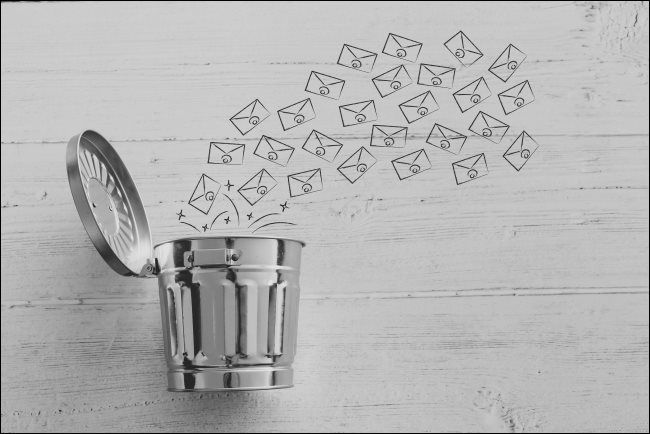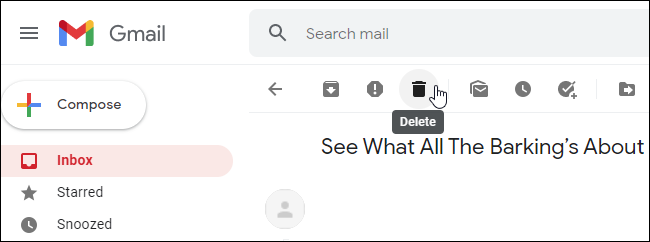Quick Links
We've all been trained to archive every email we get. After all, we have basically infinite storage, and we can just find all the emails we need with a quick search, right? Makes sense. But that's a trap.
Gmail Promised Endless Storage but Hasn't Kept up
Whether or not you use Gmail, it's important to understand that the idea of never deleting emails was widely popularized by Gmail. Before that, people generally deleted their emails regularly. You had to delete them to free up space so that you could get more emails.
Gmail was earth-shattering when it was launched back in 2004. Google's email service delivered a whopping 1 GB of free email storage. That put its competitors to shame---the free version of Microsoft Hotmail offered a tiny 2 MB at the time. Yes, Gmail launched with five hundred times as much free storage as Microsoft's email service. It's no wonder that Gmail became so popular. Its competitors struggled to keep up, but even they added much more storage space.
Google kept adding free storage space. In 2005, on Gmail's one-year anniversary, Gmail's free storage space was doubled to 2 GB. Georges Harik, the product management director of Gmail, said the right thing to do was "to keep giving people more space forever."
Why delete emails when Google will keep giving you more and more storage space until the end of time? As Harik pointed out, as technology advances, storage gets cheaper for Google and everyone else. Sounds good ... but Google changed its mind.
Free Google Account Storage Stalled in 2013
In 2013, Google set a limit of 15 GB of storage for a free Google account. That Google account storage was merged across all Google services: Gmail, Google Drive, and Google Photos. If you store 10 GB of files, you only have 5 GB left for emails.
Google hasn't added any free storage since then. In fact, Google is taking away the free storage space it offers for photos.
If your plan was to never delete emails and hope that Google keeps increasing your account's storage, that hasn't worked out. Your email account has been slowly filling up for the last seven or eight years.
Why Pay Money to Store Useless Emails?
Here's the thing: Google sells storage as a subscription as part of Google One. If you pay a monthly subscription fee, you get a lot more space to store your emails.
Google isn't the only company that charges extra for storage. Microsoft's Outlook.com offers 15 GB of free storage space, boosted to 50 GB if you're a paying Microsoft 365 subscriber. Apple iCloud email uses your iCloud storage, and Apple famously offers only a tiny 5 GB of free storage for all your device backups and iCloud data.
That's why companies encourage you to never delete emails. They make a profit when your email account fills up, and you have to pay for a subscription to keep storing everything.
It's a bit like a storage locker company encouraging you to never give away your useless junk. Of course they want you to keep it---they make a profit when you have to pay to store it forever.
Yes, Those Emails Are Using a Lot of Space
But how much space are emails taking up, really? Aren't they tiny? They're just text, right?
Well, if you actually have gigabytes of emails in your account, you know that isn't quite true.
Sure, individual emails are small---but they add up. If your email account is full, you have a lot of space used by useless emails. All those newsletters, notifications, alerts, and other junk you've received over the years are likely using quite a bit of space---when you add them up.
If you're using Gmail, for example, the Google One Storage page shows how much space is used by your Gmail emails.
You Don't Need Most of Them, and Search Isn't Ideal
How often do you go back and search through or look at your old emails? Sure, you probably have some important emails you want to keep---but most of them are probably not important at all. You don't need them, and you would never have noticed if you clicked "Delete" instead of "Archive" on that useless email newsletter.
What's worse, having tens or hundreds of thousands of emails makes it harder to search for the emails you do care about. "Archive everything and use search to find what you care about" becomes hard when you have 200,000 emails lying around, and you're trying to find that one important email from ten years ago.
Delete Instead of Archive, and Only Keep What You Care About
Rather than archiving every single email you get, try deleting the ones you don't care about. You'll free up space, and you won't have to pay to store useless emails.
If an email is important, archive that one---or consider placing it into a folder or label that will make it easier to find in the future. But, even if you only archive the emails you care about (instead of all emails), you'll be a lot better off.
In the USA, Emails Are "Abandoned" After 180 Days
Those are all good arguments for cleaning up your email account, even if you're not particularly concerned about email privacy. But if you are concerned about privacy, know this:
In the USA, emails are considered "abandoned" after 180 days. The government can look at these emails without a warrant thanks to the Electronic Communications Protection Act, a law passed in 1986 when electronic communications were very different.
As Wired pointed out in 2013, "It's beyond ridiculous that email (but not mail) has been left out of privacy laws."
There have been attempts to fix this loophole and require the government to get a warrant before accessing emails over 180 days old. The most notable attempt was in 2016, when the Email Privacy Act passed unanimously in the U.S. House of Representatives and went on to die in the Senate. As of January 2021, the law stands.
So, if you're storing a lot of old emails in an online account, you should keep this in mind.
Time to Delete Those Old Useless Emails
Now you just need to start cleaning up all those archived emails you've been dragging around for a decade or more.
How you do this depends on what kind of emails are taking up space. For example, if you regularly get newsletters from newsletter@example.com and you've been archiving them, search your emails for "newsletter@example.com" and delete all messages from that sender.
Here are some tips for freeing up space in Gmail.



